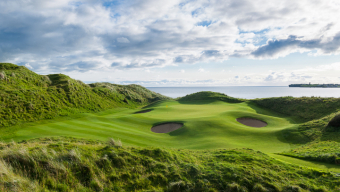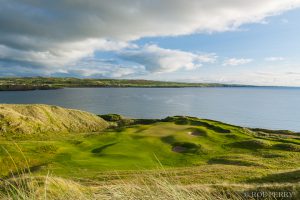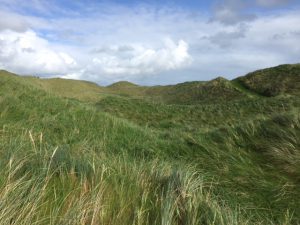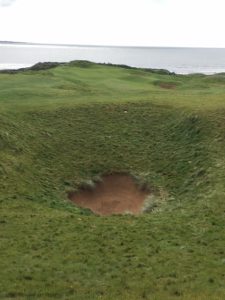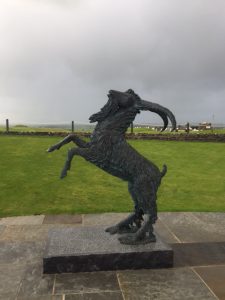Editor’s Note: During this difficult time dealing with the Coronavirus outbreak, leaving golf writers nothing to write about, we decided to revisit some of the places we have gone over the years. Today, we continue our 11-part Irish golf series at Lahinch, just a few miles from the Cliffs of Moher.
(Third of an 11-part series)
LAHINCH, County Clare, Ireland — Sometimes, you can just feel history.
It’s beneath your feet as you take an 18-hole walk-around the venerable 125-year-old Lahinch Golf Club in southwest Ireland. It’s there. You can sense the vision in the legendary figures that molded this dune-dotted, rough hew landscape into one of the greatest golf links on the planet.
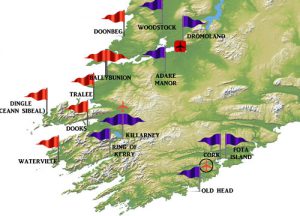 Is there any course in the world that has had such an illustrious array of designers? Old Tom Morris, Charles ‘Mo’ Gibson, Dr. Alister MacKenzie and Dr. Martin Hawtree. They are heralded titans of the industry, beginning with Old Tom in the 19th Century.
Is there any course in the world that has had such an illustrious array of designers? Old Tom Morris, Charles ‘Mo’ Gibson, Dr. Alister MacKenzie and Dr. Martin Hawtree. They are heralded titans of the industry, beginning with Old Tom in the 19th Century.
Morris, who was instrumental in starting the Open Championship in 1860 (and won it four times), went on to re-design St. Andrews, “the Home of Golf,” and was the ingenious mind behind courses such as Carnoustie, Prestwick, Muirfield and Machrihanish, among others.
He was brought over from Scotland to help lay out Lahinch in 1894. He believed it was the finest natural course he had ever seen. And while many of his holes have been changed and altered since, two remain virtually untouched, No. 4, a 475-yard, par-5, and the 154-yard, par-3 fifth hole, both with characteristic blind shots (see below).
“It was renowned when it opened,” said Paddy Keane, Lahinch’s general manager. “From day one.”
Gibson followed Old Tom, reworking the course beginning in 1907. Gibson is responsible for rerouting the course closer to the water, as No. 6 and No. 7 still carry his handiwork.
MacKenzie, the visionary behind Augusta National, Cypress Point, and Royal Melbourne, among others, showed up in 1926 and took a year to reroute and refine the layout. His philosophy was “to take what the ground gives you.”
As he was completing his work, his famous quote, perhaps a tad hyperbolic, was, “Lahinch will make the finest and most popular course that I, or I believe anyone else, has ever constructed.”
MacKenzie’s effort went virtually untouched for the next six decades until Dr. Hawtree, the English designer behind Ballybunion, Royal Birkdale and Portmarnock, was brought in the early 1990s. He rerouted four holes and added two par-3s. He created contoured grass pathways throughout and gently altered the routing in the spirit and out of respect for his predecessor, calling it “a restored MacKenzie course.”
This is a course and a membership, from the very start and through the generations, that thinks big. The result is what many have called Lahinch the “St. Andrews of Ireland,” and is consistently ranked among the top courses in the world.
“We’re in the top 50 in most publications,” Keane said. “It remains up there with the best of them.”
The best players in the world don’t need a ratings list or a press release to appreciate how well it plays. They know. They’ve always known.
The late Ken Venturi was among the first Americans to sing its praises more than 50 years ago. He is the club’s first honorary overseas life member.
Phil Mickelson has said that Lahinch and Augusta are his two favorite courses in the world. In the Venturi tradition, Mickelson is the current honorary overseas member. The club has 500 overseas members.
Stewart Cink played Lahinch the week before he won 2009 Open Championship. Luke Donald prepared here for his 2010 Open. Padraic Harrington won the 1995 Irish Open here. So many others have challenged it, from Davis Love II to Jim Furyk, Darren Clarke, Graeme McDowell and Greg Norman.
It doesn’t take long for Lahinch – or the wind – to get into your face. The 534-yard, par-5 second hole seems to span the entire course. Your second shot is likely blind over a bluff, toward the town of Lahinch, down a couple tiers, past the clubhouse and into a basin, 120 yards or so from the green. Veteran Scottish pro golfer Sam Torrance said it’s his favorite hole in the world.
Once you reach the back-to-back Old Tom Morris holes, No. 4 and No. 5, you become immersed in history, a trip back in time and into his designing mind. It’s apparent that he liked blind shots. Complete blind shots.
As you stand on the tee box on ‘The Klondyke’ fourth hole, you have to look hard as to where to land your drive. It has to be straight in the little middle of two ridiculously long fescue dunes framing the patch of fairway green. Then the fun begins. Your second shot is over one of the tallest dunes on the course. There’s a spotter on top of the dune to give you the target line, when it’s OK to hit and, subsequently, where you hit.
“If a guy designed that today,” Keane said, “he’d probably never work again.”
Another dune sits between you and the pin on the par-3 fifth, called ‘Dell.’ The green is just beyond the hill, although a first-timer wouldn’t really know how far. It’s guess and hope for all 154 yards. There’s a white rock that rests on the dune slope, offering a target line. When the pin position moves, so does the rock.
The wind. The rain. The impossibly thick fescue (load up on balls). The dunes. The pot bunkers. It doesn’t let up.
“You can’t rest out there,” Keane said.
All that trouble can easily distract a player from its linksy beauty. There may not be a more beautiful hole than the par-3, 178-yard 11th. A dandy. All down the left side is fescue-covered dunes. No escape for those who enter. Bunkers guard both right and left with dunes to the right and behind the green. It’s a narrow shot into the prevailing wind coming cold off the Atlantic, with the Cliffs of Moher in the distance.
“Twins” is the par-4, 461-yard 14th, as two sizable dunes dominate and separate you from the green. It’s a hide-and-seek shot through the dune slot to the pin.
It just continues without letup until the par-5, 534-yard 18th, toward the clubhouse. It’s a fine finishing hole as the wind is generally behind you, providing the chance for a decent score if you can avoid one of the 12 pot bunkers.
The town of Lahinch, just a short walk along the waterfront promenade, is not big but it’s lively with good restaurants and live Irish music.
Keane said the club generates about $30 million annually to the local economy. “That’s huge money to west Ireland,” he said.
Like many courses in Ireland, the course logo features an animal. In Lahinch’s case, it’s a goat. The story goes back to the 1950s when a caddy, Bobby Welsh, used to bring his goats out in the evening to munch on the grasses.
“We were looking for an emblem,” Keane added. “The goats were famous. They’re an integral part of the history of the course.”
A statue of the goat was unveiled in June, next to the clubhouse. It’s been a selfie favorite since.
Keane said he’s just a caretaker for the iconic property, graced by Morris, Gibson, MacKenzie and Hawtree before him.
“I’m just passing through,” he added. “When I walk out the gate (for good) I try to make it a better place.”
LAHINCH GOLF CLUB
Location: Lahinch, Munster, County Clare
Opened: 1892 (Castle Course: 1963)
Architects: Old Tom Morris, Charles ‘Mo’ Gibson, Dr. Alister MacKenzie, Dr. Martin Hawtree
Type: Links
Tees: Blue (6,950), White (6,613), Green (6,339), Red (5,502)
Par: 72
Green Fees: $190 (Euro) May-September; $140 (October-April)
Memorable Holes:
No. 2: Par 5, 534 yards. Sam Torrance’s favorite hole, down three tiers toward the village.
No. 4: ‘Klondyke,’ Par-5, 475 yards. Original Old Tom Morris with a giant dune hiding green.
No. 5: ‘Dell,’ Par-3, 154 yards. Another Morris original, with dune hides pin; target white stone.
No. 11: (Top photo) Par-3, 178 yards. A narrow beauty, beach and Cliffs of Moher in distance.
SUNDAY: Spanish Point





